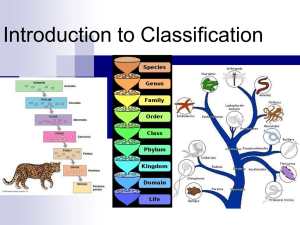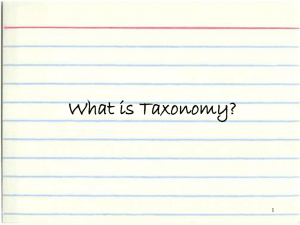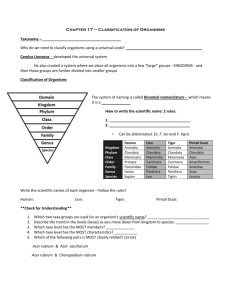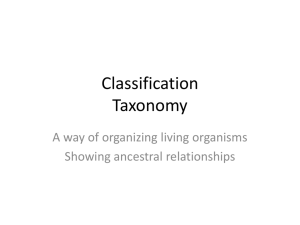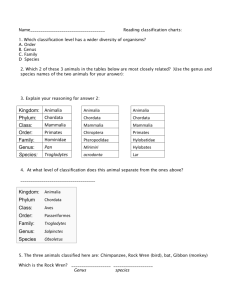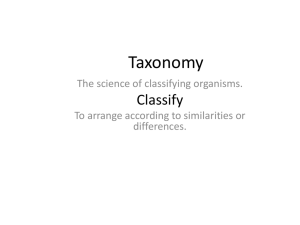Classifying Living Things
advertisement
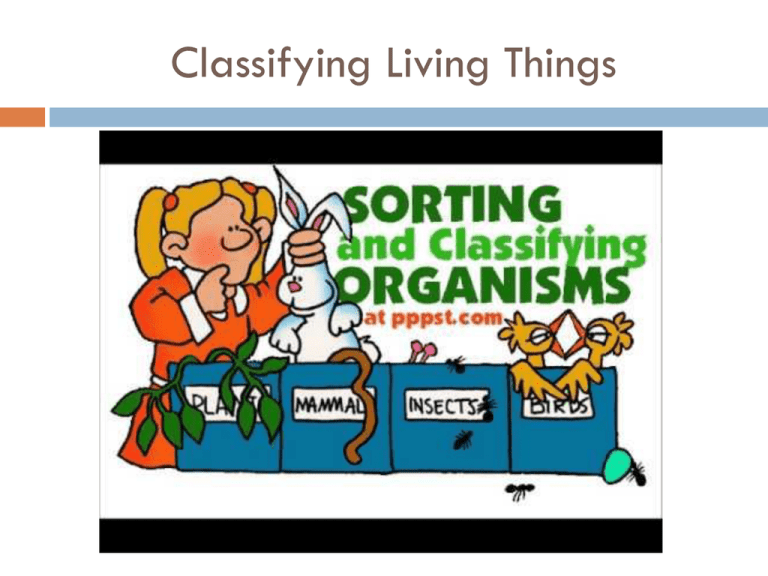
Classifying Living Things Classifying Living Things Scientists identify, define, and name species of organisms A species is a group of organisms that share similar physical features, are genetically similar, and can reproduce with one another to produce a viable offspring. Why this is important Accurately names organisms Prevents duplicated names Prevents misnomers (E.g. starfish & jellyfish arent’ fish) Universal language (latin) To show evolutionary relationships Taxonomy An organism is a living thing that is capable of reproducing, responding to stimuli, and growth. All organisms in the world can be classified into a grouping system known as Taxonomy. Taxonomy was initially created by Carl Linnaeus. Taxonomy How many species are there? About 1.4 million have been identified Nearly 2/3 are insects Scientists estimate 10-100 million (meaning most aren’t even discovered yet) Thought Experiment Imagine you were in charge of naming all living organisms. How might you divide these organisms? Taxonomy Was created by examining physical and structural features : The more features in common, the closer the ancestral relationship Binomial nomenclature is the system used to name every organism. E.g. Canis lupus (Grey Wolf) Binomial Nomenclature Binomial nomenclature is usually based on a characteristic of the organism E.g. Castor canadensis (i.e. it is from Canada) The first word Castor is known as the genus name and the second word canadensis is known as the species name. *Note that the genus name is always capitalized while the species is not. Also the entire name is italicized.* Levels of Classification The Genus and Species names are part of the 8 ranks The image on the left shows the different levels of classification (i.e. ranks) If two organisms have the same genus name they are more similar than two organisms with the same phylum name Dearest King Philip Came Over For Good Spaghetti Levels of Classification Taxon Side Note: Taxon (Plural = Taxa) is a specific rank for organisms I.e. Rank = Kingdom Taxa = Animalia E.g. Human Classification The common name is often used to name a species. The Kingdom level is the most general while the Species is most specific Common Name: Humans Scientific Name: Homo sapiens Classification Level Kingdom Phylum Class Order Family Genus Species Classification Name Animalia Chordata Mammalia Primates Hominidae Homo sapiens Which two organisms are most closely related? Classification Level Humans Grey Wolf Brown Bear Kingdom Animalia Animalia Animalia Phylum Chordata Chordata Chordata Class Mammalia Mammalia Mammalia Order Primates Carnivora Carnivora Family Hominidae Caninae Ursidae Genus Homo Canis Ursus Species sapiens lupus arctos Levels of Classification There are 3 Domains and 6 Kingdoms The Domain: First level of Classification This level breaks down living organisms into the major categories of: 1. Bacteria 2. Archaea 3. Eukarya Eukaryotes Prokaryotes Do not have a nucleus Do not have well defined organelles E.g. Bacteria and Archaea Eukaryotes Have a nucleus Have well defined membrane-bound organelles The Kingdom Taxa The six Kingdom system is commonly used: bacteria, Archaea, Protista, Fungi, Plantae, Animalia The Other Taxa Taxa for the Grey Wolf (Canis lupus) What Makes a Species a Species Lions and tigers can reproduce together and make a liger or tigon. Why then are they considered different species? + What Makes a Species a Species Recall: A species is a group of organisms that look similar and can can interbreed under natural conditions to produce fertile offspring. In other words, their children can grow and reproduce. Ligers and tigons cannot reproduce Video of Liger https://www.youtube.com/watch?v=1zOWYj59BXI Homework Read pages 10-30 #2-6 (p.13); Activity 1.1 (p.13); #2-3, 6-7, 9-10 (p.16); #9,11(p.19); #1-2, 4-7, 9 (p.30)
